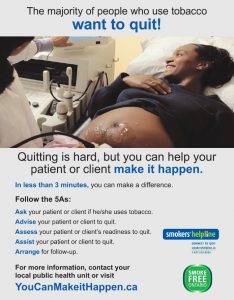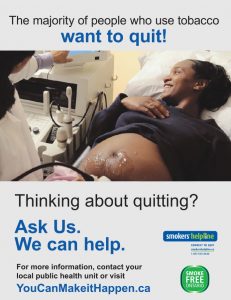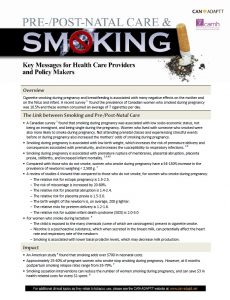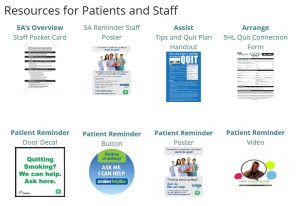REPRODUCTIVE HEALTH
Impact of interventions on tobacco use morbidity and mortality
Tobacco smoking is the single most important modifiable cause of serious long-term health risks for both the women and their babies. Smoking cessation interventions in pregnancy reduce the proportion of women who continue to smoke in late pregnancy, and reduce low birth weight and preterm birth. Low birth weight has been associated with coronary heart disease, type 2 diabetes, and being overweight in adulthood.
Smoking cessation interventions in pregnancy need to be implemented in all maternity care settings. Given the difficulty many pregnant women addicted to tobacco have quitting during pregnancy, population-based measures to reduce smoking and social inequalities should be supported.
Evidence to support tobacco dependence interventions in pregnancy
There is emergent evidence to support tobacco dependence interventions in the perinatal period. However, despite the harmful effects of smoking in the perinatal period, tobacco dependence intervention for this priority population is insufficient. In order to gain leadership support for the integration of tobacco dependence interventions into practice, it is important to incorporate evidence into planning tools and discussions with decision makers.
- CAN ADAPTT Canadian Smoking Cessation Guideline for Pregnant and Breast Feeding Women
- Interventions for Promoting Smoking cessation during Pregnancy: Article
- Expecting to Quit A Best-Practices Review of Smoking Cessation Interventions: Article
- Pregnets-Health Care Provider Literature: Reference list
- Smoking in the Preconception and Prenatal Periods: Power point- ROW
Examples of evidence-based practice systems
Why start from scratch when there are evidence-based program examples and tools which already exist to help you move your project forward. These programs include a variety of models/frameworks, templates, tools, and resources to help you plan, implement and evaluate your program. Contact the programs directly for more information or resources.
- British Columbia Centre of Excellence for Women’s Health: LIBERATION! HELPING WOMEN QUIT SMOKING: Brief Tobacco Intervention Guide
- Pregnets-Resources in Ontario
A complete and comprehensive list of maternal health programs, guidelines, data registries, webinars and literature are available on the Pregnets website.
Examples and medical directives and policies for NRT for pregnant women
Examples of patient assessment and pharmacotherapy tools
- Free stop smoking medications are available in Ontario.
Resources for reproductive health staff
Resources Tailored for Reproductive Health Patients:
Available for download. Contact your local Public Health Unit or Smokers’ Helpline for requests to adapt resources.
Examples of patient supports
Self- help tools for your patient to become tobacco-free:
- Registered Nursing Association of Ontario – Smoking cessation resources for Pre and postnatal women and their families
- Smoke Free Women – Web support for women who want to quit smoking
- Pregnets – For moms and moms-to-be
- The Pregnets blog –
If you’re interested in reading about the experiences several Ontario women have related to pregnancy and quitting smoking, we encourage you to sign up to follow the blog by email.
Fact sheets from Region of Waterloo Public Health:
The Best Start Resource Centre: Ontario’s Maternal Newborn and Early Child Development Resource Centre:
Training opportunities for reproductive health staff
Healthcare providers are considered a credible source of information by patients – you can help your patients to quit smoking, even with just a few minutes of your time.
- Training opportunities for brief interventions with patients (1-3 minutes), as well more intensive interventions (10+ minutes)
- Registered Nurses Association of Ontario (RNAO)Tobacco-Free RNAO is a comprehensive initiative including Knowledge Exchange opportunities and e-training modules designed to support nurses and other health care providers to implement the RNAO’s best practice guideline (BPG) for smoking cessation “Integrating Smoking Cessation into Daily Nursing Practice.” Smoking cessation initiative extended to pregnant and postpartum women. RNAO IABPG is excited to announce an extension of its successful seven-year smoking cessation initiative, funded by the Ministry of Health and Long Term Care, to include a focus on smoking cessation for pregnant and postpartum women
Monitoring and evaluation
An integral part of implementing a tobacco cessation system of practice is to ensure that all patients are asked about tobacco use and offered information and support to quit.
- Canadian Tobacco Use Monitoring Survey (CTUMS) 2011: Smoking and pregnancy, women age 20-44 years, Canada 2011
- Compare your local smoking in pregnancy rates to Canadian rates.







